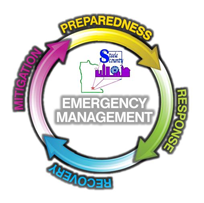- What Is an Influenza Pandemic?
A pandemic is a global disease outbreak. An influenza pandemic occurs when a new influenza A virus emerges for which there is little or no immunity in the human population, begins to cause serious illness and then spreads easily person-to-person worldwide.
Historically, the 20th century saw 3 pandemics of influenza:
- 1918 influenza pandemic caused at least 675,000 U.S. deaths and up to 50 million deaths worldwide
- 1957 influenza pandemic caused at least 70,000 U.S. deaths and 1-2 million deaths worldwide
- 1968 influenza pandemic caused about 34,000 U.S. deaths and 700,000 deaths worldwide
Characteristics and challenges of a pandemic
- Rapid Worldwide Spread
• When a pandemic influenza virus emerges, its global spread is considered inevitable.
• Preparedness activities should assume that the entire world population would be susceptible.
• Countries might, through measures such as border closures and travel restrictions, delay arrival of the virus, but cannot stop it. - Health Care Systems Overloaded
• Most people have little or no immunity to a pandemic virus. Infection and illness rates soar. A substantial percentage of the world’s population will require some form of medical care.
• Nations unlikely to have the staff, facilities, equipment and hospital beds needed to cope with large numbers of people who suddenly fall ill.
• Death rates are high, largely determined by four factors: the number of people who become infected, the virulence of the virus, the underlying characteristics and vulnerability of affected populations and the effectiveness of preventive measures.
• Past pandemics have spread globally in two and sometimes three waves. - Medical Supplies Inadequate
• The need for vaccine is likely to outstrip supply.
• The need for antiviral drugs is also likely to be inadequate early in a pandemic.
• A pandemic can create a shortage of hospital beds, ventilators and other supplies. Surge capacity at non-traditional sites such as schools may be created to cope with demand
• Difficult decisions will need to be made regarding who gets antiviral drugs and vaccines. - Economic and Social Disruption
• Travel bans, closings of schools and businesses and cancellations of events could have major impact on communities and citizens.
• Care for sick family members and fear of exposure can result in significant worker absenteeism.
Communications and Information are Critical Components of Pandemic Response
Education and outreach are critical to preparing for a pandemic. Understanding what a pandemic is, what needs to be done at all levels to prepare for pandemic influenza, and what could happen during a pandemic helps us make informed decisions both as individuals and as a nation. Should a pandemic occur the public must be able to depend on its government to provide scientifically sound public health information quickly, openly and dependably. For additional information on pandemic influenza visit: www.flu.gov.
You can prepare for an influenza pandemic now. You should know both the magnitude of what can happen during a pandemic outbreak and what actions you can take to help lessen the impact of an influenza pandemic on you and your family. This checklist will help you gather the information and resources you may need in case of a flu pandemic.
- To plan for a pandemic:
• Store a two week supply of water and food. During a pandemic, if you cannot get to a store, or if stores are out of supplies, it will be important for you to have extra supplies on hand. This can be useful in other types of emergencies, such as power outages and disasters.
• Have any nonprescription drugs and other health supplies on hand, including pain relievers, stomach remedies, cough and cold medicines, fluids with electrolytes, and vitamins.
• Talk with family members and loved ones about how they would be cared for if they got sick, or what will be needed to care for them in your home.
• Volunteer with local groups to prepare and assist with emergency response.
• Get involved in your community as it works to prepare for an influenza pandemic. - To limit the spread of germs and prevent infection:
• Teach your children to wash hands frequently with soap and water, and model the correct behavior.
• Teach your children to cover coughs and sneezes with tissues, and be sure to model that behavior.
• Teach your children to stay away from others as much as possible if they are sick. Stay home from work and school if sick. - Items to have on hand for an extended stay at home:
| Examples of food and non-perishables | Examples of medical, health, and emergency supplies |
| • Ready-to-eat canned meats, fish, fruits, vegetables, beans, and soups • Protein or fruit bars • Dry cereal or granola • Peanut butter or nuts • Dried fruit • Crackers • Canned juices • Bottled water • Canned or jarred baby food and formula • Pet food • Other non-perishable items | • Prescribed medical supplies such as glucose and blood-pressure monitoring equipment • Soap and water, or alcohol-based (60-95%) hand wash • Medicines for fever, such as acetaminophen or ibuprofen • Thermometer • Anti-diarrheal medication • Vitamins • Fluids with electrolytes • Cleansing agent/soap • Flashlight • Batteries • Portable radio • Manual can opener • Garbage bags • Tissues, toilet paper, disposable diapers |
Information from The Centers for Disease Control and Prevention (CDC) hotline, 1-800-CDC-INFO (1-800-232-4636), is available in English and Spanish, 24 hours a day, 7 days a week. TTY: 1-888-232-6348. Questions can be e-mailed to cdcinfo@cdc.gov.
Updated 09-Sep-2019
